
BIRDS AS ART BULLETIN 202
Visit www.birdsasart.com
BAA KUDOS
LensCoats™ NOW AVAILABLE FROM BAA
DELKIN e-FILM PRO COMPACT FLASH CARDS
CORNY CORRECTION
IPT UPDATES
GALAPAGOS 2007 PHOTO CRUISE/YACHT BELUGA
HUNT’S SPECIALS
Contact us by phone at 863-692-0906 (Eastern Time Zone) or by e-mail at birdsasart@att.net or birdsasart@verizon.net. The att address is best from overseas.
We gladly accept credit card orders by phone 8am till
You can use the Paypal links on the web site to order anything. Just type in the item(s) and the amount due. If using your own Paypal account, please send to either of the e-mail addresses above.
Photographic Theme: Some of my favorite bird-scapes.

Image copyright 2006: Arthur Morris/BIRDS AS ART
Canon 28-135mm IS lens (handheld at 28mm) with EOS-1Ds Mark. ISO 400. Evaluative Metering -1/3 stop (to lessen over-exposure of the brightest parts of the sky): 1/30 sec. at f/22.
Note that the horizon has been placed well below the horizontal centerline. I made lots of similar images but this one--with the right-pointing triangle of beach at the bottom of the frame--was the strongest composition.
Bird-scapes are simply scenic
images in which the bird, a small group of birds, or a flock of birds are small
(or tiny) in the frame and take a backseat to the surrounding habitat or to the
landscape. While my style is generally large-in-the-frame and bold and graphic
with out-of-focus backgrounds, I have--for more than a year now--found myself
looking to create wider images that depict lots of habitat and lots of sky.
(Great cloud formations or sunset colors are a huge plus when creating
bird-scapes.) I guess that the timing coincides with my purchase of the Canon
EF 70-200mm F/2.8 IS L lens. Do note however that there are times when the best
tool for creating a pleasing bird-scape is a 500mm or 600mm lens. Another part
of my motivation is all those folks who come up to me and say something like,
"If I had a long lens like you, I could make great pictures too..." I am
writing this Bulletin in
The first thing that you need to do to create a good bird-scape is to recognize that a beautiful scene indeed lies before you. Next, choose the lens or focal length that will allow you to frame the image that way that you want. If I am working near my car, I will generally work on a tripod. This allows for absolute control of the framing and will produce sharper images. If I am away from my vehicle, on a beautiful beach somewhere, I will almost always have either the 70-200f/2.8 L IS or the 28-135 IS lens (or both) with me. As I have been working more and more with the Mark II 1Ds and its full frame sensor (I had two of them with me on the UT/MT trip), I often use the 70-200/f2.8 for my bird-scapes; the true 70mm focal length that I get with this combination is wide enough in most situations. I have just received my new Canon EF 24-105mm IS L lens and will always have that one with me in the field, even when I bring the 70-200. In any case, when I am away from the vehicle I will either handhold the 28-135 or the 70-200 for bird-scapes, or, if I need some extra depth-of-field, support the 70-200 on my big lens like this:
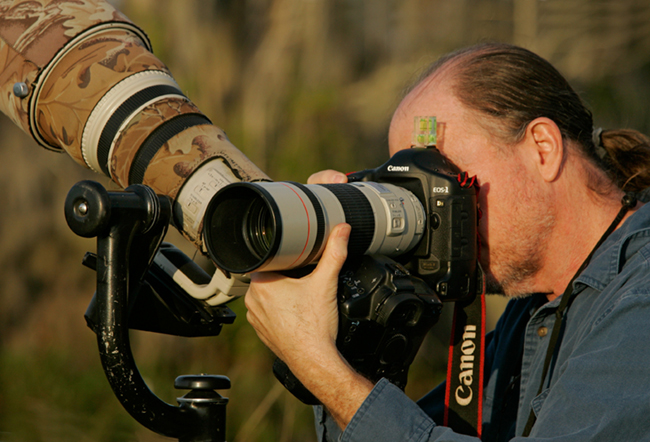
Lens on Lens Sharpness Technique, Indian
Image copyright 2006: Jim Litzenberg/BIRDS AS ART
Jim created a series of excellent images depicting various advanced sharpness techniques for "The Art of Bird Photography II" (on CD only).
Visit http://www.birdsasart.com/ABPII.htm for details and purchase options.
I always use either One-Shot AF or Custom Function 4-3 so that I can focus on the bird or the closest birds in a group or a flock and recompose. With a single bird or a small group, I will generally place the bird or birds in a corner of the frame as a sort of compositional anchor. Be aware of the trees, bushes, rocks, hills, or mountains in the distance or on the horizon line and strive to choose a perspective and a framing that allows you to create a balanced composition. It is best to keep the horizon line away from the center the frame unless (as rarely happens...) the upper and lower halves the image are equally dramatic. Once you are happy with your composition, wait for a good head angle or two (if applicable) and depress the shutter button a few times.
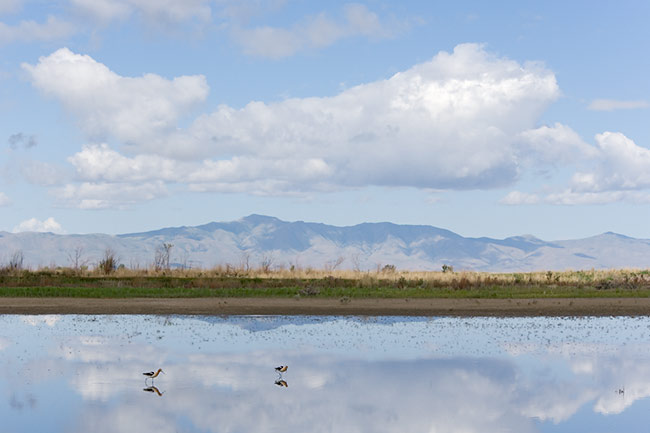
American Avocets in Roadside Pond, near Bear River Migratory Bird Refuge, UT
Image copyright 2006: Arthur Morris/BIRDS AS ART
Canon 70-200mm IS L lens with 1.4X II TC (handheld at 98mm) with EOS-1Ds Mark. . ISO 400. Evaluative Metering +2/3 stop: 1/800 sec. at f/11.
I was first attracted to this scene by the great clouds. The key to making a successful bird-scape here was getting the birds out of the center of the frame and waiting for a pleasing arrangement of the two avocets. Here, the horizon was placed neatly and conveniently one-third of the way up in the frame. Note also that I chose a perspective that placed the taller trees and bushes on the left side of the frame. Had they been centered they would have been distracting...
The
We are now accepting
registrations. Paypal is best but we will be glad to take your credit card
information by phone (863-692-0906) or to cash your check. If sending a check,
please make it out to “Arthur Morris” and send it to us at BIRDS AS ART,
The cost of the weekend
seminar will be $159. The cost of a single day will be $99. Register with a
friend or spouse and take $10 off each registration. Here is our Cancellation
Policy: If for any reason you need to withdraw, please notify us ASAP. Once
we receive your e-mail, phone call, or written notice of your cancellation the
following fees apply: cancel before
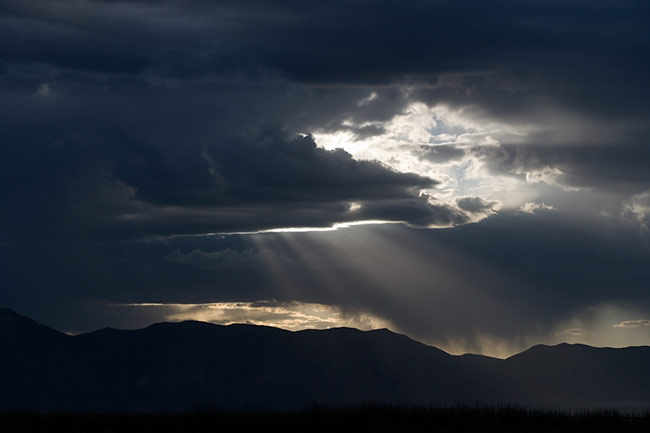
Storm Clouds above
Image copyright 2006: Arthur Morris/BIRDS AS ART
Canon 28-135mm IS lens (handheld at 125mm) with EOS-1Ds Mark. ISO 400. Evaluative Metering -1 stop (again, to lessen over-exposure of the brightest parts of the sky): 1/1600 sec. at f/10.
It Ain't Just Birds. Seeing and working wider than I usually do allows me to create new and different images. Photographs like this have great potential for stock sales.
If you are a member of a local
camera club or natural history society anywhere in the western
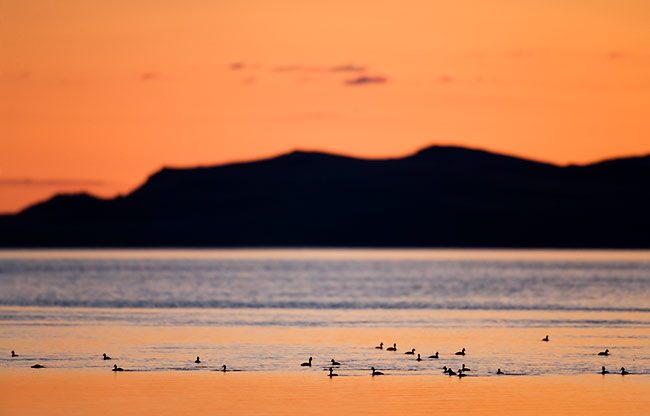
Eared Grebes at sunset,
Image copyright 2006: Arthur Morris/BIRDS AS ART
Canon 600mm f/4L IS lens with EOS-1Ds Mark. ISO 400. Evaluative Metering +1 stop: 1/800 sec. at f/4.
While I was dreaming of making some great close-up images of this beautiful
species, it was not to be in
BAA KUDOS
DIGITAL BASICS
From Vincent Scarnnechia by e-mail:
Hi Artie, Thank you for the May Digital Basics update. I can say for certain that Digital Basics provides a wealth of very good information. It is the equivalent to a $250.00 Photoshop workshop for only $20.00. Vincent
From Jim Ferris by e-mail:
Dear Art, All in all I find your Digital Basics publication an excellent resource to help me in processing my bird photos. It is precisely what I have been looking for and is a great help because it is specific to this particular application. I have read tons of reference and training publications on Photoshop but they are, of necessity, very general in nature which requires one to wade through a lot of material in hopes of finding just what is needed to solve a problem.
Best and thanks, Jim
IPTs
From Layton Parham by e-mail:
Dear Artie, I just wanted to thank you for the second best weekend I can remember. Only my wife knows about the very best weekend! Two weeks before the IPT, I had never seen Photoshop, but with Digital Basics and your masterful teaching, I am now photographing and producing really great pix (minus UFOs--unwanted foreign objects. I love to ride my Harley Davidson and go deep sea fishing, but if someone asked me what one thing I would most want to do, I would say "Go on another IPT!" I was amazed at all the great people that attended the St Augustine IPT. Every one was helpful. A special thanks to you, Artie, for your constant advice, and to Jim and Alfred for all of their help. I plan to attend another IPT ASAP.
Thanks and best
wishes,
From Lori Bolle (whose name I inadvertently omitted in the St. Augustine IPT report--sorry Lori!) via e-mail:
Hi Artie, I had
a wonderful time at
From Vince Lamb (Nikon user) by e-mail:
Hi Artie, I
came to
BLUBBs
From Cindy Creighton via e-mail:
Hi Artie,
I just wanted to drop
you a quick line to tell about my experience using the BLUBB for the last couple
of weeks in the field. So far, I absolutely LOVE IT! Thanks to the Blubb, I
was able to make a sharp image of a Short-eared Owl at
(Note: we currently have two BLUBBs available from our next shipment of 20…)
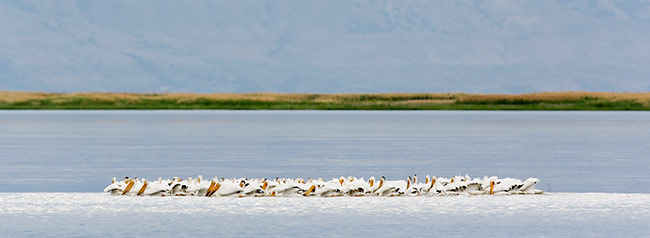
White Pelicans feeding, Bear River Migratory Bird Refuge, UT
Image copyright 2006: Arthur Morris/BIRDS AS ART
Canon 600mm f/4L IS lens (on BLUBB) with EOS-1Ds Mark. ISO 400. Evaluative Metering at zero: 1/1600 sec. at f/8.
It was the strip of green marsh that inspired me to create this bird scape. With the cloudy bright conditions, I was able position the car for the most pleasing background without worrying much about sun angle.
LensCoats™ NOW AVAILABLE FROM BAA
BIRDS AS ART is proud to announce that in addition to carrying JRF Lens Covers, we now offer the complete line of LensCoat™ protective neoprene covers. Lens Coats are available in four distinct patterns for virtually all modern Canon and Nikon lenses. And, LensCoat™ offers a set of covers for both the Canon and Nikon teleconverters. My favorite LensCoat™ feature is the flexible UV-PVC window that covers the lens controls; it is thin and flexible enough so that you can--as long as you have a decent fingernail on your pointer finger--work the controls without having to pull back the cover.
Like the JRF covers, LensCoat™ covers protect the finish of your lenses, provide camouflage, and provide a thermal barrier that makes it easier to handle your lens in unusually hot or cold conditions. You can check out (and order) the great variety of LensCoat™ covers and patterns here:
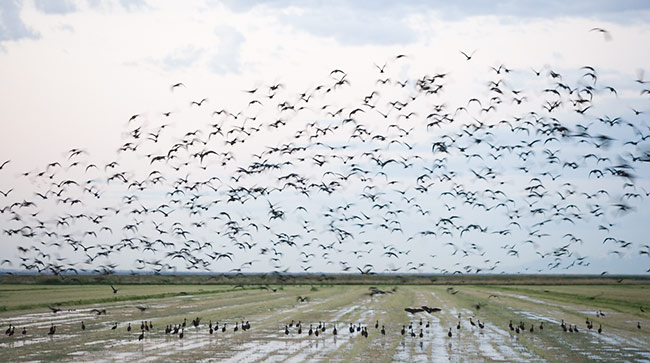
White-faced
Ibis flock in farm field,
Image copyright 2006: Arthur Morris/BIRDS AS ART
Canon 70-200mm IS L lens (handheld at 145mm) with EOS-1Ds Mark. ISO 400. Evaluative Metering +1 2/3 stops: 1/30 sec. at f/2.8.
If you look at the aperture, shutter speed, and ISO here you will note that this image was created in near darkness. I used 45-Point AFPS and focused on the birds in flight. Whenever you are in your vehicle for the purpose of photography you should have an intermediate telephoto zoom lens ready and loaded...
CORNY CORRECTION
I received the following by e-mail:
Artie, I wanted
to let you know that the photo of the Great-tailed Grackle in Bulletin 200
should not have been captioned as him sitting on "corn flowers", but as being on
maize grain heads. Maize is is also known as milo, or sorghum. The orange,
round seeds from this plant are found in many bird seed mixes. It is grown in
many huge fields
here in the
Editorial note:
As far as I know, Great-tailed Grackles have been around a lot longer than
farmers... And the grackles are not the ones who have destroyed thousands of
acres
Note: Linda Lee also questioned my corn ID. Heck, I was taught in elementary school that maize and corn were the same thing! Go figure…
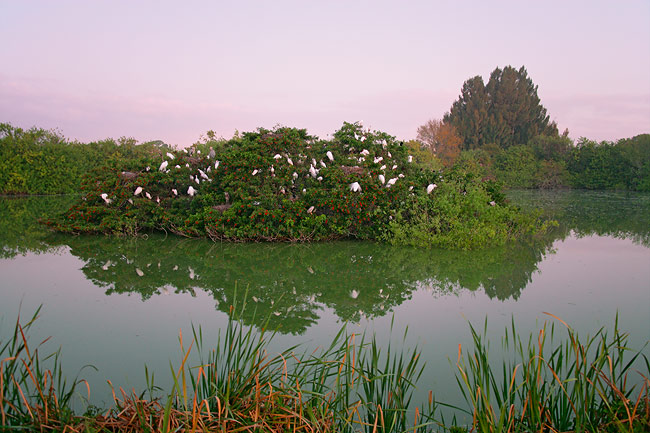
Venice Rookery, pre-dawn, Venice, FL
Image
copyright 2006:
Canon 28-135mm IS lens (tripod mounted at 35mm) with EOS-1Ds Mark. ISO 400. Evaluative Metering -1/3 stop: 2 sec. at f/3.5.
There was barely enough light to focus manually when I made this image. Digital can do amazing things in the dark if you realize the possibilities. I keep a Wimberley P-5 camera body plate in my bag and only put it on the camera when I need it.
DELKIN e-FILM PRO COMPACT FLASH CARDS
As most of you know, I have used Delkin e-Film Pro Compact Flash Cards for more than 3 ˝ years now and have found them to be fast and dependable. I have been using the Delkin 2gb and 4gb cards exclusively now for more than two years and have experienced one card failure, that with a very old 2gb card about a month ago. Delkin promptly replaced the card. Do remember that I take tens of thousands of images in a given year. We have joined with Delkin to ensure that we can offer you the great e-Film Pro Cards at very low prices in any quantity that you might need:
1gb Delkin e-film Pro Card: $49.98
2gb Delkin e-film Pro Card: $80.98
4gb Delkin e-film Pro Card: $144.98
8gb Delkin e-film Pro Card: $299.98
Please add $7.00
per order shipping and handling.
IPT UPDATES
All four Bosque
IPTs are almost all filled.
If you want to join us
in
GALAPAGOS PHOTO
CRUISES/YACHT BELUGA: SUMMER
Bosque #1: "The Fall Color IPT"
Bosque #2:
"The Pre-Thanksgiving IPT"
Bosque #3:
"The Post-Thanksgiving IPT"
Bosque #4: "The Full Moon IPT" DEC 4 (mid-day) through DEC 7 (mid day), 2006. 3-DAY: $929. (Limit 14 Openings: 3) Slide Program mid-day on DEC 4. Co-leaders: Manuel Presti (2005 Wildlife Photographer of the Year) and Robert Amoruso. This IPT includes a half day of photography on the 4th, two full days of photography on the 5th and 6th, and a final half day on December 7th. Limit 14. This IPT has been scheduled to maximize the opportunities to include the rising and setting full (DEC 5) and near-full moon in your images. There will be lots of the usual chances as well, and this time period has provided more than its share of spectacular sunrises and sunsets over the years.
FORT DESOTO IPT: APR 13-15, 2007. Slide program on the evening of Thursday, APR 12. 3-DAY: $999 (Limit 14.) Courtship and breeding behaviors of Laughing Gull and Royal and Sandwich Tern. Herons, egrets (including both dark and light phase Reddish Egret), shorebirds (including Long-billed Curlew), gulls, terns, and skimmers among others.

Bald Eagle above wintry mountains, Homer, AK
Image copyright 2006: Arthur Morris/BIRDS AS ART
Canon 70-200mm f/2.8 L IS lens (handheld at 120mm) with EOS 1Ds MII. ISO 400.
Evaluative Metering +1 stop off the light-blue sky: 1/1000 sec. at f/6.3.
This is my very favorite bird-scape image. There is nothing more satisfying than pre-visualizing an image, teaching the concept to the group, and then making an image as perfect as the one that you saw in your mind. I explained to the Homer IPT group that by using 45 point AFPS in AI Servo mode it would be possible to make an image featuring an eagle in flight well off center while working wide enough to include the distant snow-covered mountains and a strip of Cook Inlet. There was a bit of luck involved in catching such a spectacular wing position, but luck favors the well prepared...
GALAPAGOS 2007 PHOTO CRUISE/YACHT BELUGA
I will be
leading my fourth Galapagos Photo Cruise for Distinctive Journeys,
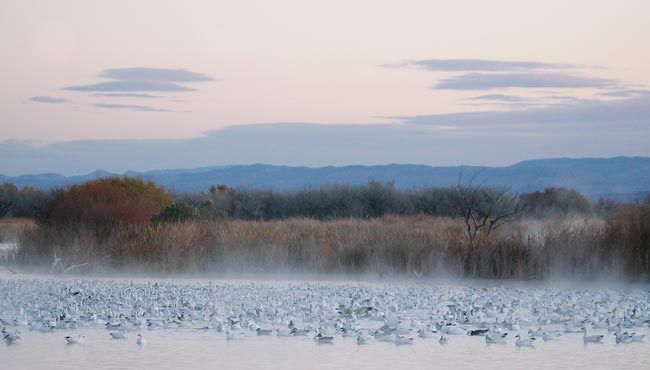
Snow Geese, "Paybooth Pond with Fog," Bosque Del Apache NWR,
Image copyright2005: Arthur Morris/BIRDS ASART
Canon EF 70-200mm f/2.8L IS lens (on 1325 tripod with Mongoose M-262head) and EOS 1Dn Mark II. ISO 400.Evaluative metering +2/3 stop:1/60sec. at f/5.
Here, I focused--as I always do in these situations-- on the first row of birds using (One-Shot AF/central sensor only) and then re-composed. On my first scouting morning at Bosque in 2005, the birds blasted off and flew to the Paybooth Pond; nobody noticed but me... It pays to keep your eyes open at all times when photographing nature…
HUNT’S SPECIALS

Contact: Gary Farber, Tel#800-221-1830 ext. 2332, Fax#800-336-3841,
BIRDS AS ART (Prices valid through end of June, 2006)
Birds as Art subscribers looking for Canon 5D, 1D Mark II N, and Canon 30D, call for prices. Specials prices are too low to be put in print. Ask about the price of the Canon 1DS Mark II (Artie’s very favorite camera).
Canon CPE3 battery (Arthur now prefers this by light-years over any Quantum external battery): $139.99
Ask about prices on all Canon lenses including 600F4, 500 F4, 70-200 IS, 100-400
etc. Hunt’s only carries
Call about prices on flashes, extension tubes, digital paper trimmers, extenders, etc. from Promaster.
Canon PowerShot A75….factory refurbished $119.99
Canon Power Shot S31S $449.99
Photos CS2 Upgrade $149.99
Photo CS Full version $579.00
Velvia 50-36 (Presently in stock) Per roll $ 4.99
New Velvia 100-36 Per roll $ 5.19
New Velvia 100-36 60 + rolls Per roll $ 4.99
Epson P2000 (Before $50.00 mail in rebate) $399.99
Epson P4000 (Before $50.00 mail in rebate) $579.99
Contact Gary Farber for all your photo, video, and digital needs.

Canada Geese on prairie, Bear River Migratory Bird Refuge, UT
Image copyright 2006: Arthur Morris/BIRDS AS ART
Canon 600mm f/4L IS lens with 1.4X II TC (on BLUBB) with EOS-1Ds Mark. ISO 400. Evaluative Metering +2/3 stop: 1/125 sec. at f/5.6.
The geese in
Best and love and great picture-making to all,
artie
Note: Arthur Morris has been a Canon contract photographer since 1994 and continues in that role today. Hunt's Photo of Boston, MA is a BAA sponsor as it Delkin Devices. Back issues of all BAA Bulletins can be found in the Bulletin Archives which may be accessed from the home page at www.birdsasart.com